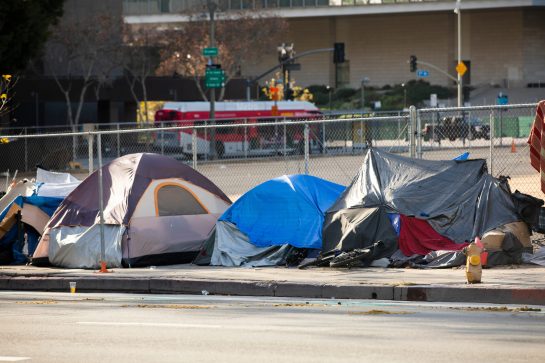When summer comes, so do rising temperatures and blistering heat, especially with increasing global temperatures. For people experiencing homelessness, this change can be dangerous—even deadly. How can homeless services best prepare for the coming summer?
Homelessness in the USA
Did you know more than 500,000 individuals are estimated to be experiencing homelessness in the United States? These include men, women, veterans, youth, and even entire families.
People experience homelessness for many reasons, including growing income inequalities, housing shortages, and adverse social determinants of health (just to name a few).
No matter the reason, experiencing homelessness is a tough road to walk down. People in this situation often must rely on social-service organizations to meet their basic needs. Shelters, food banks, health clinics, and other similar agencies provide critical—and often life-saving resources—to these individuals.
While the need for these services persists year round, support is not always as consistent.
Many people are aware of the perils of winter on those experiencing homelessness (i.e., freezing temperatures), and donations often increase during this season. But what about during the hot summer months? Unfortunately, not as many people associate summer with difficulties for homeless populations. However, the reality is that summer can be one of the most dangerous times for these communities—and we need to be ready to help the best we can.
Why Is Summer So Dangerous?
Many erroneously believe that because temperatures don’t drop to freezing temperatures in the summer that people experiencing homelessness are safe—even comfortable—without adequate shelter. Unfortunately, this could not be further from the truth.
Summer brings its own extreme temperatures that can cause just as many health problems for unhoused individuals. Common health problems arising from the heat include:
- Dehydration
- Sunburn
- Heatstroke
- Dizziness
- Delirium
- Heat blisters
- Rashes
- Infections
- Sun poisoning
These conditions can quickly prove harmful, even fatal. While the solution for most is to escape the heat inside, people experiencing homelessness don’t have that luxury.
Summer also presents challenges for unhoused families. When schools let out children for summer break, parents might not have anywhere safe for their children to spend the day. These kids are therefore forced to face the heat alongside their families. On top of this difficulty, many of these children rely on schools to provide adequate nutrition for them, meaning that summer also brings increased hunger.
The reality is that as temperatures rise, so do the needs of those experiencing homelessness. The good news? There are things that individuals, organizations, and communities can do now to begin preparing for the difficulties of summertime.
How to Help Beat the Heat
With summer just around the corner, there is no time like the present to begin preparing to ease the burden on unhoused people. Knowing what to expect is half the battle for making summer a safer season. Consider these three tips below on what to expect and how to adjust for the summertime.
1) Changing Needs
People often know what homeless shelters need during the winter (e.g., socks, coats, and blankets) but what about the summer? Here are just a few of the items in high demand during the summer months:
- Light summer clothing
- Bottled water
- Umbrellas (for sun and rain protection)
- Sunscreen
- Sunburn relief (i.e., aloe vera)
- Insect repellant
- Anti-itch creams
- Sunhats
- Non-perishable food
Communities and organizations should begin now to gather these supplies in preparation for the increased need during the sweltering summer season.
2) Low Awareness
If there’s one thing homeless services should be prepared for, it’s low awareness among the general population regarding what homeless populations need.
While the winter season is often associated with giving and charity (thus increasing charitable donations), summertime does not have the same cultural connotation. Families and communities may be instead focused on finishing school, starting summer camps, and going on vacation, meaning that agencies must work twice as hard to raise awareness and increase donations.
The bright side of this season is that summer often means increased community gatherings, such as Independence Day celebrations, pool days at local recreation centers, and large outdoor markets. Each of these marks an opportunity for organizations to attend and raise awareness among communities.
3) Unpredictable Weather
While most days from June to August will be hot and sunny, summer also means unpredictable storms. Flooding, torrential rains, and even hurricanes can appear suddenly during the summer, and people experiencing homelessness must often take the brunt of the weather.
Shelters, individuals, and communities should prepare for unpredictable weather by ensuring that as many resources as possible are stockpiled for rain and thunderstorms. Be ready to offer temporary shelter for unhoused individuals to escape any rains or wind.
Individuals can assist with adjusting to inclement weather by watching weather forecasts carefully and rallying their networks when storms arise.
Homelessness in the Summer
While experiencing homelessness is never an easy thing, it can become increasingly difficult during the summer months. By knowing what to expect and how to prepare for the challenges of these hotter weeks, communities can better support those without a shelter over their head.



